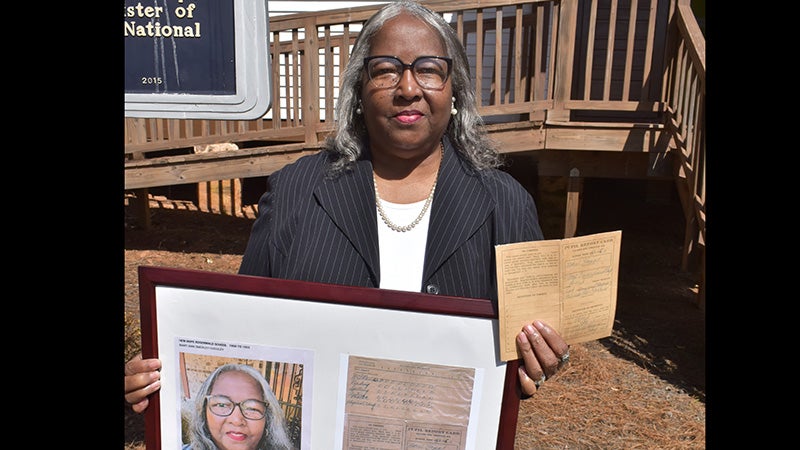New Hope Rosenwald School hosts open house
Published 12:00 pm Tuesday, February 27, 2024
|
Getting your Trinity Audio player ready...
|
FREDONIA — George Barrow was pleasantly surprised by the turnout at Saturday afternoon’s open house at the New Hope Rosenwald School.
“I wasn’t expecting this many people,” he said. “It’s good there’s this much interest about this building and what we’re doing here.”
Barrow is the president of the school’s board of directors and is very active in an ongoing restoration at the school, which opened in 1919 and remained open until the late 1950s.
The New Hope Foundation, Inc. was founded by the late John D. Hoggs as a 501(c)3 charitable organization with the mission to preserve and restore the historic New Hope Rosenwald School. Following Mr. Hoggs’ death in 2013, the foundation was reorganized under new management to complete this mission. In addition to Mr. Barrow, other current board members include Project Manager Nicholas Fannings, Construction Planner/Treasurer Thermond Billingslea and Marketing Director Gene Thornton.
After the school closed in 1958, the building was modified to serve as a home for an elderly couple. These changes included having a screened-in front porch. During the early planning of restoration a consensus decision was reached to return the school to its original design as much as possible.
The building’s original appearance was based on Floor Plan No. 11, designed by famed Tuskegee architect Robert R. Taylor (1868-1942). Taylor was the first African-American student to enroll at MIT and became the first African-American architect to be licensed in the U.S. Tuskegee Institute President Booker T. Washington persuaded him to come to Tuskegee, where he played a leading role in transforming the campus. Many historic buildings at Tuskegee, including the famed chapel, have Taylor’s influence. Taylor also worked with the Rosenwald School program.
There’s a model inside the New Hope School that depicts how the present building can be enlarged according to Taylor’s designs. An extension can be added to the back. This would include a kitchen and the bathrooms.
“We’d like for the front part of the building to be a museum,” Barrow explained. “We now have a bathroom in what was once a cloak room. We’d like to be able to move the bathroom into the new addition and restore the cloakroom. We’d move the kitchen into the new extension and put some historic wood burning stoves where the kitchen is now.”
The present building is being used for reunions of former Rosenwald students, family reunions and the like. It’s in lovely rural setting and is an enjoyable play to be.
LaFayette resident Mary Huguley was at the open house. She brought with her a framed collage of her connection to the school. “I was four years old when I started school here,” she said. “We had to walk to and from school every day. It took us two hours each way. Kids who complain about riding a school bus don’t know how good they have it.”
Huguley said she would never forget her teacher, Sally Harris. “She was both our principal and teacher,” she said. “She would divide us into groups according to age. There was a partition in the middle of the room. The younger children were on one side and the older kids on the other side. There’s lots of special memories in this place.”
Huguley treasures one of the report cards she received from Miss Sally. She still has it.
There’s a vintage partition back in place in the building. A potbellied stove is on one side. Miss Sally’s original teacher’s desk and chair have been restored to near pristine condition. Behind the desk is a blackboard. It’s from the Rosenwald period but not from the original school. The original blackboard crumbled away with age. The place underneath the backboard where the chalk is kept is original.
Pains are being taken to have the building restored as historically accurate as possible. This is by no means an easy task, but needs to be done according to standards set by the Alabama Historical Commission. Their blessings of the work being done helps with getting grants.
Contractors are carefully selected to make sure they build back with the type of materials that were in use in 1919. It’s just not the same today. In 1919 a 2-by-4 piece of lumber two inches thick and four inches wide. That changed with the national size standards that were adopted in 1924. Today’s one-by-four is actually 0.75 inches thick and 3.5 inches wide. A 2×8 is 1.5 inches thick and 7.25 inches wide. A two-by-four is 1.5 inches thick and 3.5 inches wide.
It can’t be built back the way it was with the lumber being produced by today’s sawmills.
A signature feature of a Rosenwald school are the tall windows that let in abundant light. Few schools in the rural South had electricity during the Rosenwald era. Sunlight and wood burning stoves kept the building warm on cold days. The building sitting on stone piers helped keep in ventilated on warm days.
Double-hung sash windows were common in Rosenwald schools. This name refers to a window with two sashes that can move up and down in the window frame. With multiple windows situated close together, ample light flowed into the building. It provided both better lighting and ventilation.
Barrow would like to see some improvements on the school campus. He visualizes a walking path around the kind of playground that existed on a Rosenwald campus. He’s also like to see a well house on the original well site. “We want it to look like a park,” he said.
Fundraising for the restoration began with some hamburger suppers thanks to Sheriff Sid Lockhart. More substantial funding has come from the Alabama Historical Commission, the Charter Foundation, the Coosa Valley RC&D, the Chattahoochee Valley Historical Society and the Wehadkee Foundation. Donations from churches and individuals has helped as well.
In the first half of the 20 century, Chambers County was home to 20 of Alabama’s 389 Rosenwald schools. The New Hope School has been listed on the National Register of Historic Places since 2002. It gained National Treasure status in 2011. The school cost $1,200 to build back in 1919. One-third of that amount came from the Rosenwald Foundation, $400 from the state and $400 from the local African-American community.
By the 1930s, more than 5,000 Rosenwald schools were scattered across the Southern states. The vast majority of them were in rural settings. Prior to the Rosenwald school program, little in the way of education was being provided to African-American children in these areas. What education that was provided was being offered in churches, lodge halls, and farm buildings. Few of these places had adequate teaching materials.
The Rosenwald Schools Initiative began as a collaboration between Julius Rosenwald and Booker T. Washington. Rosenwald was the son of German Jewish immigrants who had come to the U.S. in the 1800s to escape the antisemitism that was rampant in Europe at the time. He rose to become the president of the Sears Roebuck Company, and sympathized with those who had been discriminated against, whether it be Jews in Europe or Blacks in the U.S.
Washington had built a number of schools in Alabama before Rosenwald joined him in the effort. The first six Rosenwald schools were built in Alabama in 1913, the first two being in Notasulga and Loachapoka.
Framed photos on the wall inside the New Hope School tell of the Rosenwald-Booker T. Washington collaboration and of Robert Taylor’s role in the school building effort. There are also photos of founder John Hoggs along with early supporters Oscar Crawley, Lanny B. Davis, Jeanette Washington ands Susye Griggs.
Barrow attended a Rosenwald school in Five Points in his youth. He went on to earn a B.S. in engineering from Tennessee State University and a Masters from the University of Michigan. He worked for a number of years for General Motors. He’s retired now and enjoying life back home in Chambers County.




